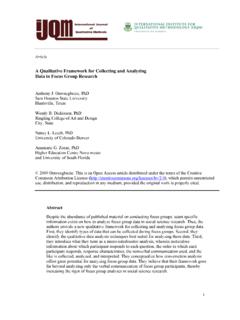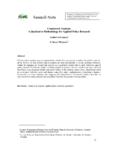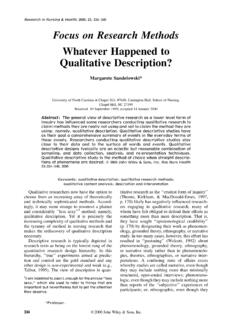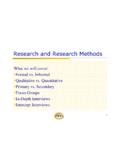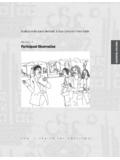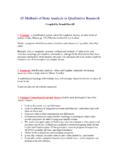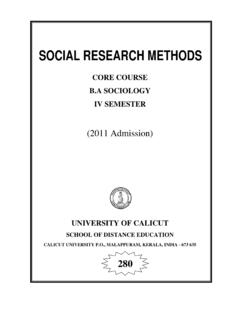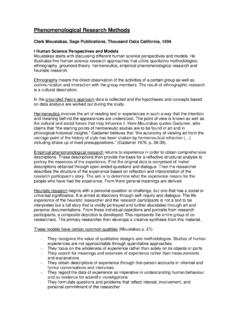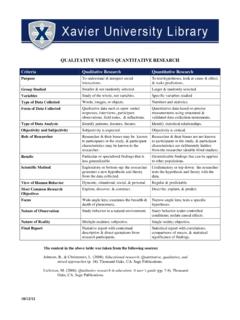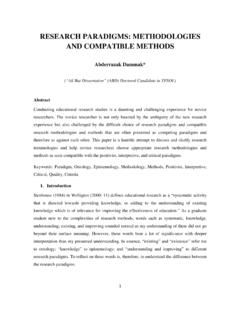Transcription of Triangulation in Social Research: Qualitative and ...
1 Triangulation in Social research : Qualitative and Quantitative methods Can Really Be Mixed FINAL VERSION. Forthcoming as a chapter in Developments in Sociology, 2004, ed. M. Holborn, Ormskirk: Causeway Press. By Wendy Olsen Abstract For those who teach methodology within Social science departments, notably sociology, the mixing of quantitative and Qualitative methods presents an ongoing problem. Recent developments in the philosophy of science have argued that the two traditions should not have a separate-but-equal status, and should instead interact. By reviewing three positions about this issue ('empiricist', constructionist, and realist) the chapter offers a review of the sociological approach now known as Triangulation . The chapter refers to several empirical examples that illustrate the realist position and its strengths. The conclusion of the chapter is a more abstract review of the debate over pluralism in methodology.
2 Triangulation , I argue, is not aimed merely at validation but at deepening and widening one's understanding. As a research aim, this one can be achieved either by a person or by a research team or group. Triangulation and pluralism both tend to support interdisciplinary research rather than a strongly bounded discipline of sociology. (For a copy of this book, you may contact Causeway Press on 01695 576048, email ISBN 1902796829.) 1 Biographical Note Wendy Olsen Wendy Olsen grew up in Indiana and moved at age 18 to Beloit College in Wisconsin, where she studied economics and politics in a liberal arts degree. She moved to Britain in 1981 to study at Oxford University, where she received a masters and doctoral degree in economics. Her doctoral research was based on extended fieldwork in southern Indian villages and was inter-disciplinary. She now works at Manchester University as a lecturer in socio-economic research .
3 She has research experience in India, Sri Lanka and Ghana as well as in the United Kingdom. Her research activities include interviewing and statistics as well as advice to government. She presently conducts research on behalf of the Equal Opportunities Commission as well as having three research grants (all involving teamwork) from the Economic and Social research Council. 2 Triangulation in Social research : Qualitative and Quantitative methods Can Really Be Mixed 1. Triangulation In Social science Triangulation is defined as the mixing of data or methods so that diverse viewpoints or standpoints cast light upon a topic. The mixing of data types, known as data Triangulation , is often thought to help in validating the claims that might arise from an initial pilot study. The mixing of methodologies, mixing the use of survey data with interviews, is a more profound form of Triangulation . Denzin wrote a justification for Triangulation in 1970 and is credited by some with initiating the move toward integrated research that mixes methods (Denzin, 1970, 1979, 1989; see Flick s review, 1992).
4 However other authors in other contexts have used mixed methods research both before and after Denzin s summary was written. For instance, Lenin used a mixture of quantitative data tables along with a political-economy analysis of charged words used in his classic research monograph, The Development of Capitalism in Russia (1898). Lenin, following Marx s 1840s-1860s writings, was a critic of bourgeois political economy and wanted to un-pick the discourse of capitalism in order to be a critic of the capitalist system. We would today say that his work used methodological Triangulation of discourse analysis (a Qualitative methodology), and survey data (a quantitative methodology), to study the end of the Russian peasantry and the early beginnings of working class conflict with employers in Russia. For students today, then, it is important not to locate Triangulation too late in the growth of sociological thinking.
5 The discipline as it now exists has developed through a thriving interaction of quantitative and Qualitative analysis. Textbooks help by providing a review of changing methodologies (Hughes et al. 2003). The main argument of this chapter is that there should not be a contradiction between these two modes of analysis, but rather that it should be possible to bring them together to shed light on any chosen Social research topic. 3 The chapter will begin with some general points about how the philosophy of science has been moving toward this particular integration of methods , and how in the 1980s it was more common to perceive an antipathy of Qualitative research to quantitative research . The more one perceives and teaches this kind of antipathy the worse the chasm gets. This antipathy is called an epistemological chasm, following work by Walby (2001) who noted that such chasms are usual between disciplines but that they are hard to justify philosophically.
6 In the middle of the chapter I provide some research exemplars which bridge the chasm and succeed in integrating Qualitative insights with the interpretation of quantitative survey data. The chapter concludes with a rejection of pure constructionism, which is the idea that all Social objects are merely socially constructed. This idea is rejected only in a guarded sense. Constructionism itself appears too simplistic to serve as a methodology in itself (as did positivism, and as does empiricism; see Fay, 1996). A realist alternative has been offered (Sayer, 1992). Realism argues that Social objects are often affected by the way they are construed, but that they also have an ongoing real existence that is not constituted entirely by how today s researchers construe them (Sayer, 2000). Whilst ultimately changeable, the real has characteristics which are, in part, unresponsive to how we know about them.
7 Realism is plural with respect to methodologies and with respect to theories, and therefore offers a good platform from which to embark on integrated mixed- methods research . This conclusion is consistent with the leading sociologists in this area such as Bryman, Sayer, Dex, and others who are cited in the chapter. After working as a socio-economist using a wide range of methods and methodologies, my conclusion is that Triangulation is something we do in order to generate a dialectic of learning. Triangulation means mixing approaches to get two or three viewpoints upon the things being studied. The resulting dialectic of learning thrives on the contrasts between what seems self-evident in interviews, what seems to underlie the lay discourses, what appears to be generally true in surveys, and what differences arise when comparing all these with official interpretations of the same thing. Valuing academic research careers is a way of valuing the ongoing dialectic of learning, and Triangulation plays an important role in good Social research .
8 In making this argument I tend to undermine the separation of quantitative and Qualitative 4methods teaching in colleges and universities. Instead, one might argue, it is valuable to teach research design skills and interpretive skills, which can be used with regard to a wide range of data types. Indeed, like some other critics of quantitative methods , I would argue that far too much time is spent by statisticians on statistics, when it would be interesting for them to spend more time on developing alternative interpretations (and triangulated re-interpretations) of the data they have. Perhaps a fetishism of quantitative methods is the problem which now needs to be addressed in Social science. Fifty years ago and thirty years ago it was positivism which was under attack ( (Cicourel 1964); see (Crotty 1998) for a summary of changes over time). That attack has been very successful in making positivism out-dated, but these days there is still an empiricist mathematics-fetishism that can be very off-putting to Qualitative researchers.
9 For instance, if we look at the handbooks by Goldstein or by Snijders and Bosker on multi-level statistical modelling (Goldstein 2003; Snijders and Bosker 1999), we find letters of the greek alphabet on nearly every page. The maths is so dense as to be off-putting. Byrne has developed a critique of the multi-level modelling school which recognises the advantages of the technique but questions its entirely statistical methodology (Byrne 1998). Byrne notes that multi-level statistics are at present dependent upon the quintessential survey method (Marsh, 1979, 1982). The survey method is defined by having its cases all comparable in the rows of a data table, and its variables all consistently measured in the columns. Byrne argues that we should focus on the rows of the survey data rather than the columns, ie researchers should look at the cases ( individuals) and their histories and context, their households, their culture, their city rather than attempt to make universalistic statements about the variables ( class, which is a variable in a column).
10 The traditional column-wise approach, which looks at variables, tends to lead to overly generalised interpretations (Ragin, 1987). Using variables, say the critics of statistics, stops us from looking more closely at the complex, differentiated underlying Social reality (Cilliers 1998). Let us look more closely at survey data and see whether it is correct to separate it so completely from Qualitative methods . 2. Survey research and Triangulation 5 The position taken by realists in the above debate is that methodological pluralism is an excellent starting point for empirical research . Methodological pluralism has been described in several works ( (Carter 2003; Danermark 2002; Sayer 2000)). It refers to a pluralism of method that enables the researcher to use different techniques to get access to different facets of the same Social phenomenon. For Social class studies, for instance, a methodological pluralist would examine Qualitative data on how it feels to be working-class; quantitative data on the flows of resources between classes or on their asset base; and policy documents in order to see how policies interact with or define Social classes.
